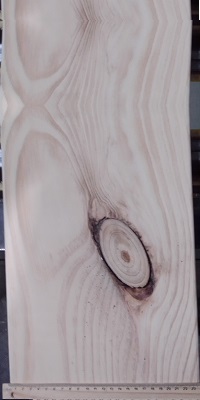Tight Encased Knot: Difference between revisions
Peter wood (talk | contribs) (Created page with "A tight encased knot is a type of knot in wood that is surrounded by cambium layer, which is the layer of tissue between the bark and the wood of a tree. This thin layer of bark or cambium serves to encase the knot, providing a protective layer around it. Despite the presence of this encasing layer, the knot itself remains tight and securely fixed in place within the wood. This type of knot is typically found in trees that have experienced some type of injury or str...") |
Peter wood (talk | contribs) No edit summary |
||
| (15 intermediate revisions by 2 users not shown) | |||
| Line 1: | Line 1: | ||
==Australian Standard Grade Timber== | |||
overall strength and stability, depending on their location and size. | If the Knot has more than 50% cambium, than the size of the not must exceed 20 mm in diameter and no more than 2 such knots are permitted on any piece of timber. | ||
their | |||
==Canadian Standards== | |||
==US Standards== | |||
== Description == | |||
[[File:EncasedKnot80mm2.jpg|right|400px|thumb|text-top|Tight Encased Knot]] | |||
A tight encased knot, also known as an encapsulated knot, is a type of knot that is surrounded by a cambium layer, which is the layer of tissue between the bark and the wood of a tree. This thin layer of bark or cambium serves to encase the knot, providing a protective layer around it. Despite the presence of this encasing layer, the knot itself remains tight and securely fixed in place within the wood. | |||
Tight encased knots can weaken the wood's overall strength and stability, depending on their location and size. | |||
This type of knot is typically found in trees that have experienced some type of injury or stress, such as wind damage, insect infestation, or disease. When the tree responds to this stress, it may form a knot as a natural part of the healing process. Also as a tree grows, lower branches often die, and their bases may become overgrown and enclosed by subsequent layers of trunk wood, forming this type of imperfection. | |||
Latest revision as of 03:56, 9 March 2023
Australian Standard Grade Timber
If the Knot has more than 50% cambium, than the size of the not must exceed 20 mm in diameter and no more than 2 such knots are permitted on any piece of timber.
Canadian Standards
US Standards
Description
A tight encased knot, also known as an encapsulated knot, is a type of knot that is surrounded by a cambium layer, which is the layer of tissue between the bark and the wood of a tree. This thin layer of bark or cambium serves to encase the knot, providing a protective layer around it. Despite the presence of this encasing layer, the knot itself remains tight and securely fixed in place within the wood.
Tight encased knots can weaken the wood's overall strength and stability, depending on their location and size.
This type of knot is typically found in trees that have experienced some type of injury or stress, such as wind damage, insect infestation, or disease. When the tree responds to this stress, it may form a knot as a natural part of the healing process. Also as a tree grows, lower branches often die, and their bases may become overgrown and enclosed by subsequent layers of trunk wood, forming this type of imperfection.
